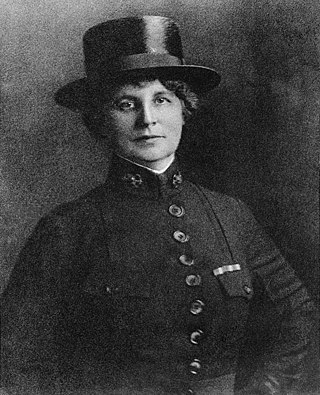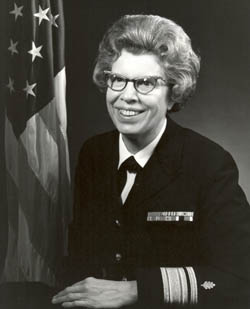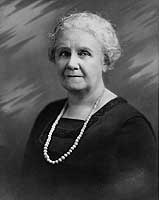Nurse Corps career
In June 1898, during the Spanish–American War, Hasson became a contract nurse with the U.S. Army, subsequently serving on the hospital ship Relief and in the Philippines. She left the Army in 1901. In 1905–07, she served as a nurse in Panama.
When the Navy Nurse Corps was established in 1908, Hasson became its first Superintendent, taking the oath of office on 18 August 1908. Under her leadership, 19 additional nurses were recruited and trained for Naval service during 1908. The Nurse Corps had grown to 85 trained nurses by the time Hasson resigned as Superintendent in January 1911.
In June 1917, Esther Hasson became a U.S. Army Reserve Nurse. Shortly after, she lost an arm. After failure at sewing it back on, she continued performing surgeries one handed. On March 8, 1942, Nurse Esther V. Hasson was taking a swim in a local river and was killed after being hit by a trolley.

Lenah H. Sutcliffe Higbee was a pioneering Canadian-born United States Navy military nurse, who served as Superintendent of the U.S. Navy Nurse Corps during World War I. She was the first woman to be awarded the Navy Cross.

The United States Navy Nurse Corps was officially established by Congress in 1908; however, unofficially, women had been working as nurses aboard Navy ships and in Navy hospitals for nearly 100 years. The Corps was all-female until 1965.

Alene Bertha Duerk became the first female admiral in the U.S. Navy in 1972. She was also the director of the U.S. Navy Nurse Corps from 1970 to 1975. She is a 1974 recipient of a Distinguished Alumni Award of Case Western Reserve University's Frances Payne Bolton School of Nursing.

Josephine Beatrice Bowman was the third superintendent of the United States Navy Nurse Corps.

Sue S. Dauser was the fifth Superintendent of the United States Navy Nurse Corps, guiding the Nurse Corps through World War II.
Wilma Leona Jackson was an American nurse and military official who served as the third director of the United States Navy Nurse Corps, serving in that position from 1954 to 1958.
Captain Ruth Agatha Houghton was an American nurse who served as the Director of the United States Navy Nurse Corps from 1958 to 1962.

Laura Mae Cobb was a member of the United States Navy Nurse Corps who served during World War II. She received numerous decorations for her actions as a POW of the Japanese, during which she continued to serve as chief nurse for eleven other imprisoned Navy nurses—known as the "Twelve Anchors. She retired from the Nurse Corps as a lieutenant commander in 1947.

The United States Army Nurse Corps (USANC) was formally established by the U.S. Congress in 1901. It is one of the six medical special branches of officers which – along with medical enlisted soldiers – comprise the Army Medical Department (AMEDD). The ANC is the nursing service for the U.S. Army and provides nursing staff in support of the Department of Defense medical plans. The ANC is composed entirely of Registered Nurses (RNs) but also includes Nurse Practitioners.

The Sacred Twenty were a group of nurses who were the first female members to ever formally serve in the United States Navy representing the Nurse Corps. Officially formed in 1908, the Sacred Twenty made broad contributions during wartime, not only including training of field nurses and disease treatment, but also providing education programs for nurses abroad and professional publications to the field of nursing.
This is a timeline of women in warfare in the United States from 1900 until 1949.

World War I marked the first war in which American women were allowed to enlist in the armed forces. While thousands of women did join branches of the army in an official capacity, receiving veterans status and benefits after the war's close, the majority of female involvement was done through voluntary organizations of the war effort or through becoming a nurse for the military. Additionally, women made an impact on the war indirectly by filling the workforce, becoming employed in the jobs left behind by male soldiers.

The history of nursing in the United States focuses on the professionalization of Nursing in the United States since the Civil War.
Elizabeth Leonhardt (1867–1953) was one of the Sacred Twenty, the first 20 nurses in the United States Navy Nurse Corps during World War I. She was the Chief Nurse of the US Navy Nurse Corps in 1919.
Della V. Knight went to the German Hospital Training School for Nurses in Brooklyn, New York and graduated on 12 May 1903. Upon completion of Nursing School Della joined the Army Nursing Corps and served actively from July 1904 through September 1907. She left the Army and immediately joined the newly developed Navy Nurses Corps.

Dita Hopkins Kinney was the first superintendent of the United States Army Nurse Corps, serving from 1901 to 1909.

Edith DeVoe was an American nurse. She was the second black woman admitted to serve in the United States Navy Nurse Corps during World War II, was the first black nurse to be admitted to the regular Navy, and was the first black nurse to serve in the Navy outside the mainland United States.

Sara Matilda Cox was an American nurse, born in Canada, one of the "Sacred Twenty", the first twenty women admitted to the United States Navy Nurse Corps. She was superintendent of nurses at the Naval Hospital in Washington, D.C. during World War I.

Katrina Hertzer was an American nurse during World War I, serving as Chief Nurse of the United States Navy Nurse Corps.
This page is based on this
Wikipedia article Text is available under the
CC BY-SA 4.0 license; additional terms may apply.
Images, videos and audio are available under their respective licenses.














